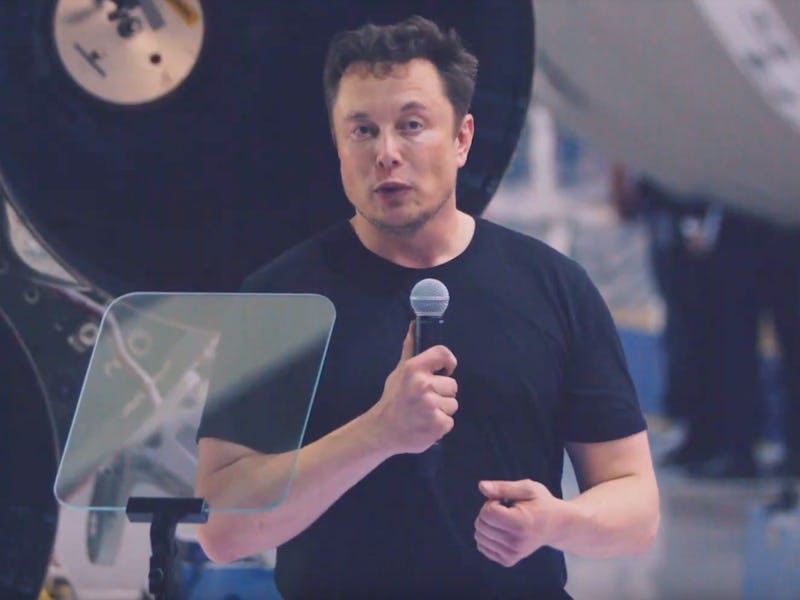SpaceX Starship: Elon Musk’s Plan to Fly Around the Moon Is Taking Shape
The stainless steel juggernaut is set to fly soon.

Slowly but surely, Elon Musk’s plan to send a human around the moon is taking shape. New details shared on Wednesday explain how his firm SpaceX plans to use its existing test rocket to build the first iteration of its moon-bound vehicle, painting a picture of how the next few years may look.
SpaceX is currently working on the Starship, a towering beast of a vehicle expected to measure around 348 feet when fully complete. This machine will be used to send Japanese billionaire Yusaku Maezawa around the moon with six to eight artists, as part of a “Dear Moon” project that will encourage the participants to produce works around their experiences.
Videos and images suggest SpaceX is working overtime to complete tests at its Boca Chica launch facility in Texas. The “Starhopper,” a miniaturized version of the full vehicle, last month completed its first untethered hop test of a few meters, demonstrating the potential viability of both the planned full-size Starship and the groundbreaking Raptor engine set to fuel its journey.
“Hopper is set to be retired after the 200 meter hop,” Chris Bergin, editor at NASASpaceFlight, explained in a forum post Wednesday. “As a result it won’t be moved back from the LZ [landing zone] - it’ll be cannibalized for parts - as the pad will be prepared for Starship MkI. And that’s where it gets really exciting.”
Musk is expected to take the stage on August 24 to explain more about how the Starship will go from water tower-looking magpie attractor to whisking a billionaire around the moon. But prior to this big reveal, enough details have emerged to paint a picture of how SpaceX gets from A to B.
SpaceX Starship: How to Build a Moon Rocket
Musk first detailed the ship that would become the Starship on September 2017. It uses Raptor engines powered by liquid oxygen and methane, unlike traditional rocket propellant, which means humans can land on other planets, set up a propellant depot, refuel and return home. The ship is designed to also take on the same satellite-launching role as the Falcon 9 and Falcon Heavy.
In September 2018, Musk announced his plan to send Maezawa around the moon. Maezawa, founder of online clothing retailer ZOZO, planned to use the four-to-five day mission in 2023 to inspire a new series of artworks.
“These artists will be asked to create something when they return to Earth,” explained Maezawa. “These masterpieces will inspire the dreamer inside all of us. Needless to say, we’ve always been inspired by the Moon. Take for example, Beethoven’s Moonlight Sonata, Van Gogh’s Starry Night, and The Beatles’ Mr. Moonlight.”
Maezawa's trajectory.
After the presentation, the “BFR” transformed into the stainless steel Starship. The company started developing the “Starhopper,” a vehicle around a third the size of the planned orbital prototype. It applied for a permit to run its hop tests in November 2018. By April, it had completed its first tethered firing.
The project took a big step forward last month when the “Starhopper” made a non-tethered hop of a few meters at the Boca Chica launch facility. This test was set as a personal milestone for Musk, who previously promised that SpaceX would share an update on the Starship project after the non-tethered hop was completed.
Based on Musk’s previous comments and Bergin’s details, what will likely happen next is the company will attempt a 200-meter hop. Assuming that goes correctly, the “Starhopper” may be retired and its components used to build an orbital prototype.
The Starship on Mars.
Unlike the Starhopper that used one Raptor engine, this will use three engines to offer bigger boosts. It’s still a way off from the expected 41 total in the final Starship, which is expected to produce a total liftoff thrust of 5,400 tons. But while Musk previously suggested the orbital prototype wouldn’t be ready until 2020, videos and images show versions under construction in both Florida and Texas are making big progress. An orbital launch could happen as soon as this year, based on executive comments.
Once the orbital prototype completes a test flight, SpaceX will likely move on to more rigorous tests. Musk suggested in September 2018 that the company would be “wise” to complete a full, unmanned lunar test flight before putting Maezawa and any of the passengers on board.
SpaceX is also expected to complete a different mission with the Starship before the moon-bound mission. Last month, SpaceX vice president of commercial sales Jonathan Hofeller told an audience that the full Starship could be operational by 2020. This would pave the way for a commercial client to launch a satellite using the ship, possibly as early as 2021. The first client is expected to be one of three telecommunications companies.
When the Maezawa flight is complete, it’s expected to pave the way for even more ambitious missions. Planned future journeys include a human mission to Mars, establishing basic life support and developing into a city by 2050.